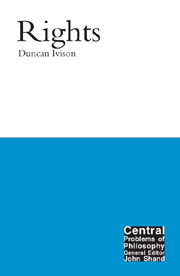1 - A naturalistic approach
Summary
A right, after all, is neither a gun, nor a one-man show. It is a relationship and a social practice, and in both of those essential aspects it is seemingly an expression of connectedness.
(Michelman 1986: 91)Introduction
Before we begin to engage with the various substantive theories of rights on offer, I want to lay out my approach to these questions a bit more explicitly. Although the book is intended as an introduction, among other things, its structure and organization reflect my own substantive views about the subject. How could it not? There are three ways in which I am going to approach the question of rights and I want to introduce them here: first, we should think of rights as representing a complex social practice; secondly, we shall aim for what I shall call a naturalistic approach to rights in general; and finally, among the different ways of characterizing rights, we shall focus on rights as statuses, instruments and conduits. Let me say some more about each of these now.
Rights as a social practice
Philosophers often want to keep two ways of approaching a concept or value separate, and for good reason. On the one hand, there is the project of philosophical justification, and on the other, the project of description or history. It is one thing to justify something, and quite another to describe it or show how it works, or how it was used by such and such a culture or person.
- Type
- Chapter
- Information
- Rights , pp. 17 - 36Publisher: Acumen PublishingPrint publication year: 2007

